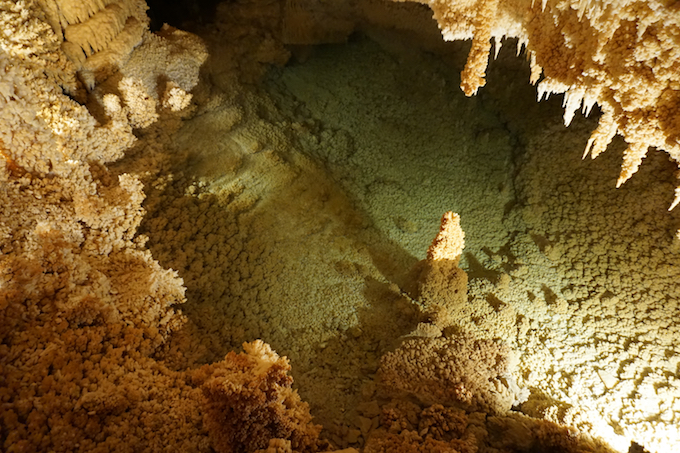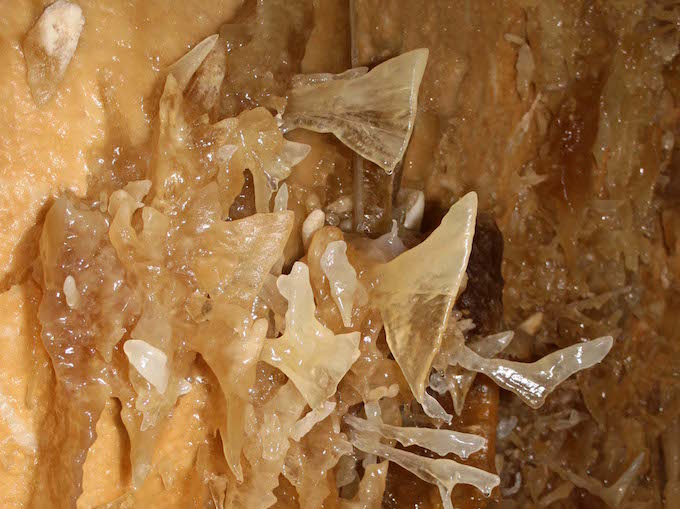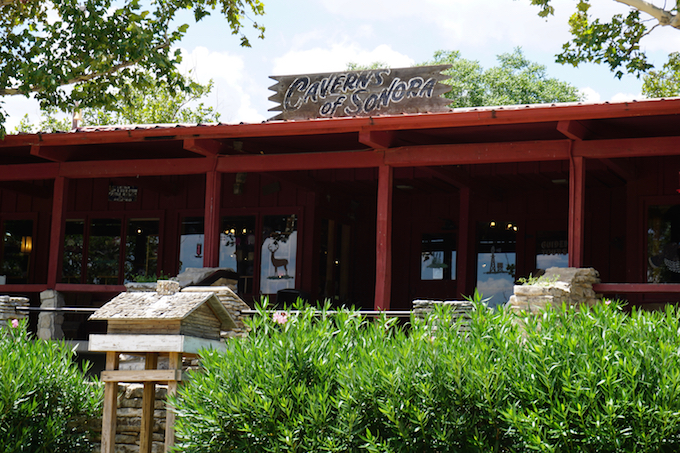Photos by Marcy Stellfox (except where otherwise noted)
Colton Moore, 27, knows the Caverns of Sonora like the back of his hand. And well he should. The cave was in his backyard, literally; it was his playground. He grew up on the Mayfield Ranch where the cave was discovered. Moore says, “I’ve been told that when my mom was leading cave tours, I’d come along in the baby carrier.” He’s been exploring the caverns for nearly 30 years and still sees new things each time he goes down.

Cave developer Jack Burch squats over the 18-inch hole that led to the discovery of the Caverns of Sonora.
The Mayfield family has owned this ranch just outside the small town of Sonora in Sutton County for generations. Family legend says that one day in 1905, a ranch dog chased a raccoon down a hole. The 18-inch hole that the raccoon dove into for safety opened into what is now known as the Caverns of Sonora.
 Word spread of the discovery. Four college kids from SMU decided to spend a long weekend exploring the cave. They met up with three other more experienced cavers from Abilene. The guys from Abilene had already explored the 500-ft cave that was accessible from the original opening and although they could see caverns opening every direction while inside, a giant pit now known as the Devil’s Pit kept them from going further into the cave. But the college kids made an important discovery that weekend. Crossing a narrow ledge to the right of Devil’s Pit on the outside, the boys found access to the caverns from the other side of the pit.
Word spread of the discovery. Four college kids from SMU decided to spend a long weekend exploring the cave. They met up with three other more experienced cavers from Abilene. The guys from Abilene had already explored the 500-ft cave that was accessible from the original opening and although they could see caverns opening every direction while inside, a giant pit now known as the Devil’s Pit kept them from going further into the cave. But the college kids made an important discovery that weekend. Crossing a narrow ledge to the right of Devil’s Pit on the outside, the boys found access to the caverns from the other side of the pit.

Once stories began to circulate about the formations inside the caverns, more and more cavers wanted to experience the cave themselves.
Enter Jack Burch. Burch, a caver from Oklahoma, developed caves for the public to visit. Burch lived his motto, “conservation through commercialization,” and when he saw the negative impact on the cave from explorers before him, he decided to step in. He feared that if a trail system or pathway wasn’t created, the curious visitors would destroy the cave. So he partnered with Mayfield and took on the cave on as a project. Burch became so passionate about developing the cave that he sold his own farm in Oklahoma to help fund the cause and moved to the ranch.
The cave first opened in 1960. What was at first, an out and back trip of about one mile in total has grown over time and evolved into an over two-mile trek through separate entrance and exit points. And while Moore enjoys talking about the history of the cave, it’s when he’s leading a tour down the dark, drippy pathways that his passion and love of the cave become evident. He says, “It’s a geological wonder.” And that’s an understatement.

Colton Moore explains about the different varieties of formations found inside the cave.
Gasses which escaped from a fault line mixed with water from the Edwards Aquifer causing the water to become extremely acidic. Over time the acidic water dissolved the limestone creating the cave. Moore, self-described as environmentally conscious, says, “The cave developed for millions of years, and then we shed light on it.” Sometimes he has trouble with the fact that the cave, which experiences 30K visitors per year, may have been better left alone. Oils and debris like dust and mud, hair, and clothing fibers can all impact the growth of the formations, even “killing” them. He feels a great responsibility for cleaning up the cave and maintaining it for others to enjoy. But he acknowledges that keeping the cave open to the public is a double-edged sword.

Horseshoe Lake
Not long after you’ve gone below ground, the tour takes you through winding pathways of smooth walls and limestone. Looking up you see holes in the ceiling where gas met with water and dissolved away the limestone. The size of the caverns you walk through is impressive, but this is the dead part of the cave. You haven’t even begun to scratch the surface of the living part of the cave.
“Every square centimeter of the cave is covered in calcite,” says Moore. The relative mix of water, minerals, and pressure create all the different types of speleothems (formations). Moore says, “It’s the variety and concentration of the formations” that sets the Caverns of Sonora apart from other caves.

Cave popcorn (aka as cave cauliflower).
Snaking down the pathways with Moore, you’ll think your eyes are playing tricks on you. It’s like you’ve gone underground into a fairy world where different parts of the cavern come to life. You’ll see the cave chandeliers, where stalactites have formed closely together on the ceiling. The result–formations that resemble light fixtures. Wads of cotton seem to stem from the walls, otherwise known as cave popcorn or cave cauliflower. Cave drapes jut from the walls their folds looking so soft that you’re tempted to reach out and touch them.
Cave bacon will have you smacking your lips while wondering at the tiny slivers of layering that look like the marbling in bacon cooked to perfection. Marvel at cave soda straws, long, thin, hollow formations the exact diameter of a water drop. Or cave coral, like cave popcorn but growing up from the ground instead of out from the walls.
 Photo: Wikipedia/common wiki/DanielCD
Photo: Wikipedia/common wiki/DanielCD
According to Wikipedia, helictites are the most fragile of cave formations. Caused by capillary pressure, helictites can grow vertically from their axis resulting in even more miraculous formations like the fishtails pictured above. The Caverns of Sonora were once known for a helictite formation that had a common starting point but then formed in two separate directions causing the formation to look like butterfly wings. Sadly, in 2006, a tourist broke off one of the wings to take as a souvenir. Though the person suspected went to court, the piece removed from the cave was never recovered, and the suspect never proven guilty.

Close up of a cluster helictite formations.
After the incident, the Mayfield family and cave management put special protocols in place to keep this type of destruction happening again. The incident also led to legislation which makes touching or removing anything from a cave a felony.
As we exit the cave, Moore talks about attending a recent meeting in San Antonio of the National Cave and Karst Research Institute (NCKRI). He tells of talking with some of the most well-respected and experienced cavers in the world. He says how one expert pulled him aside and said of the Caverns of Sonora, “I always tell people, if you’re in the Northern Hemisphere, you need to see this cave.” Moore shakes his head and says he feels pretty humbled that someone so well-respected in the field thinks so much of his family’s cave. This place is a true Texas Hill Country wonder. Make the time to go see it.
 Caverns of Sonora, 1711 Private Road 4468, Sonora, Texas; Phone: 325-387-3105; Hours: March 1st to Labor Day – 8 a.m. to 6 p.m., Tuesday after Labor Day to Feb. 29th – 9 a.m. to 5 p.m.
Caverns of Sonora, 1711 Private Road 4468, Sonora, Texas; Phone: 325-387-3105; Hours: March 1st to Labor Day – 8 a.m. to 6 p.m., Tuesday after Labor Day to Feb. 29th – 9 a.m. to 5 p.m.
 Marcy Stellfox
Marcy Stellfox

 Word spread of the discovery. Four college kids from SMU decided to spend a long weekend exploring the cave. They met up with three other more experienced cavers from Abilene. The guys from Abilene had already explored the 500-ft cave that was accessible from the original opening and although they could see caverns opening every direction while inside, a giant pit now known as the Devil’s Pit kept them from going further into the cave. But the college kids made an important discovery that weekend. Crossing a narrow ledge to the right of Devil’s Pit on the outside, the boys found access to the caverns from the other side of the pit.
Word spread of the discovery. Four college kids from SMU decided to spend a long weekend exploring the cave. They met up with three other more experienced cavers from Abilene. The guys from Abilene had already explored the 500-ft cave that was accessible from the original opening and although they could see caverns opening every direction while inside, a giant pit now known as the Devil’s Pit kept them from going further into the cave. But the college kids made an important discovery that weekend. Crossing a narrow ledge to the right of Devil’s Pit on the outside, the boys found access to the caverns from the other side of the pit.



 Photo: Wikipedia/common wiki/DanielCD
Photo: Wikipedia/common wiki/DanielCD
 Caverns of Sonora, 1711 Private Road 4468, Sonora, Texas; Phone: 325-387-3105; Hours: March 1st to Labor Day – 8 a.m. to 6 p.m., Tuesday after Labor Day to Feb. 29th – 9 a.m. to 5 p.m.
Caverns of Sonora, 1711 Private Road 4468, Sonora, Texas; Phone: 325-387-3105; Hours: March 1st to Labor Day – 8 a.m. to 6 p.m., Tuesday after Labor Day to Feb. 29th – 9 a.m. to 5 p.m.

